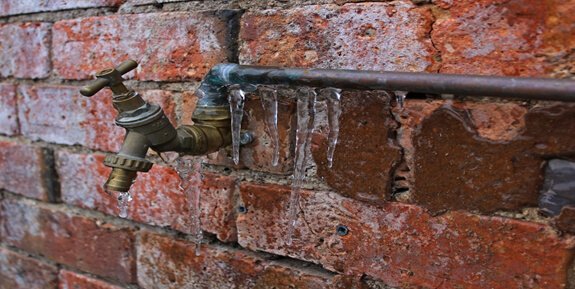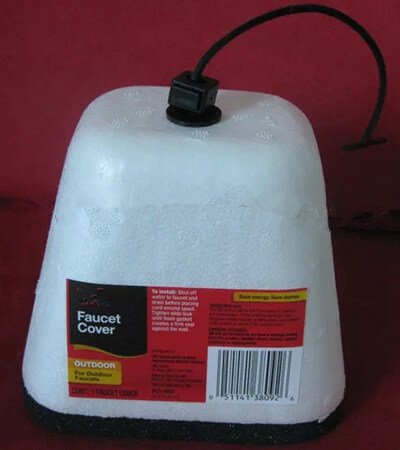
Image by G J Whitby from Pixabay
Are you checking the weather and realizing it’s time to winterize your outdoor pipes and fittings? One low-cost yet effective option is to use foam faucet covers or faucet socks over your taps.
The damage caused by a frozen pipe can be quite a surprise for homeowners who experience it. Safe-guarding against it is the best approach. This also applies in mildly temperate locations. The rare occasions that temperatures dip below freezing might catch you off guard. So, protecting your pipes with a faucet cover of your choice is a good idea.
In this article, you will learn quick, easy, and effective faucet cover installation. We’ll kick things off with a look at why you should be using them. Also included are some of the other steps you can take to winterize your pipes before you install a foam faucet cover or a faucet sock. Both options are available from weatherization companies like Daoseal.
4 Reasons You Should Use Faucet Protector Covers
There are some pretty good reasons for wanting to protect your outside faucets. While winterizing is a key reason, there are other factors that make year-round use of faucet covers desirable.
-
Childproofing your faucets

Kids love playing in the water. That’s just a fact. It’s fun for them but it adds to your water bill. It can escalate quickly if the pipe is not turned off properly after your kiddo is done with all the water play. Image by Free-Photos from Pixabay
Fitting a foam or plastic faucet cover over the tap will solve that problem. You can then be more in control of how much water your little one uses. That leaves you more in charge of how much you pay for water at the end of the billing cycle,too.
-
Pest prevention
A protective faucet cover will keep bugs out of your home. Regardless of the time of year, pests will have a tendency to crawl into your home through gaps around the pipe. They tend to do it more often in winter as they are seeking somewhere to hide from the elements.
-
Stop pipes from freezing
Water has the unique characteristic of expanding as it approaches its freezing point. As fascinating as that might be to the scientist in you, it should make the homeowner in you shudder with fear. Ice needs extra room as it freezes and expands. If necessary, it will break through your pipes to get that extra room.
It is a good idea to switch out to frost-proof or freeze-proof faucets if you don’t already have them. They are not an absolute guarantee, however, that your pipes will not freeze. Faucet covers give your faucets an extra layer of protection against the cold.
- Stop drafts entering your home
Older pipes are prone to having gaps and spaces where they enter the wall. This is a sure avenue for drafts to get in through. Newly installed pipes and fittings, on the other hand, are likely to be properly sealed where they enter the wall. This is not a surety, however. Even the faucet itself can be an entry point for cold air into your home.
Each of these is a reason to use a winterizing cover over your outdoor faucets. Drafts that get in will lower the comfort level of your home. At the same time, they keep your energy usage high as you try to compensate for them.
Things to Do Before Installing Your Faucet Protector Cover
You will want to do all you can to protect your pipes from below-freezing temperatures. Installing a faucet sock or foam faucet cover is just a part of the job. Here are a few other precautions you should take. Do these before you put the faucet protector on. They will help to ensure your pipes, faucets, and home are properly winterized.
√ Remove hoses and fittings.
You should store your hose away from the cold since water left inside a hose can freeze, expand, and damage it. Remember to remove spitters, sprayers, and any other fittings you may have on your pipe, as well.
√ Look for and fix leaks.
Dripping faucets are a warning sign. They say you may have a washer or cartridge that is damaged and needs replacement. Carry out all necessary repairs before installing the faucet protector. Keep the other outdoor fixtures installed on your pipes in mind, too. Yard hydrants, sprayers, and spitters, for example, should be inspected and repaired, as well.
√ Allow faucets to drain – where possible.
Water remaining in the pipe and faucet will expand on freezing. Apart from damaging the pipe and faucet, there is also the danger of damage to the house, itself. Broken pipes will become leaking pipes once the thaw sets in.
To drain the faucet, first shut off the water leading to it. Next, open the spigot and leave it open for a few hours. This will let any water in it drain out. Turn it back off and move to the next step – fitting the protective winterizing cover over it.
Simple and Easy – How to Install Faucet Covers
A frozen outdoor faucet can lead to hundreds of thousands of dollars in damage and repair to your home. A faucet cover can be installed in less than a minute. It will help to ensure you are not saddled with that kind of bill.
Here’s how to quickly and securely fit (i) a foam faucet cover and (ii) a faucet sock over a tap.
(i) Installing a foam faucet cover

- Loop Hook the protector’s loop over the handle or spigot of the faucet. It should fit in such a way that it cannot slip off.
- Compress: Push the faucet cover onto the wall. Hold if firmly in place. This compresses its base against the wall and creates an airtight seal.
- Pull: While holding the faucet cover in place with one hand, use the other hand to grip the ring at the back of the cover. Pull the drawstring out toward you as far as it will go. Push down the drawstring’s attachment so that it is secure against the foam cover. You can see it sitting on top of Daoseal’s faucet protector in the picture shown. It holds the cover in place over the faucet and against the wall.
- Check: Double-check that the faucet cover is firmly in place and well-sealed against the wall. Remove and adjust it if it is not.

(ii) Installing a faucet sock
1. Slip-on
Open up the sock. Slip it over the faucet. Adjust it so that the faucet sticks out into the sock and is completely covered. Avoid squishing the
protective sock down over the tap. Leave it sticking out and looking puffy. This traps a layer of air around the faucet inside it. That air will act as extra insulation for the faucet.
- Secure
Use the attached ties or hook-and-loop fasteners to secure the sock onto the pipe behind the faucet. Pull it tight, as you are trying to create an airtight seal to trap the air inside and keep the cold air out.
Bottom Line: Should You Opt for Protective Faucet Covers in the Winter?
Prevention is better than cure. Just ask any homeowner who has ever had to pay for repairs to damage caused by frozen and busted pipes. We recommend taking the preventative step of using faucet covers.
They are inexpensive. Plus, they are easy to install and they do the job you want them to do, as long as you fit them properly. You have the choice of using plastic faucet covers or foam faucet covers. Insulated faucet socks are an option, too.
Don’t be left out in the cold. Make use of these simple solutions that are available to you.


